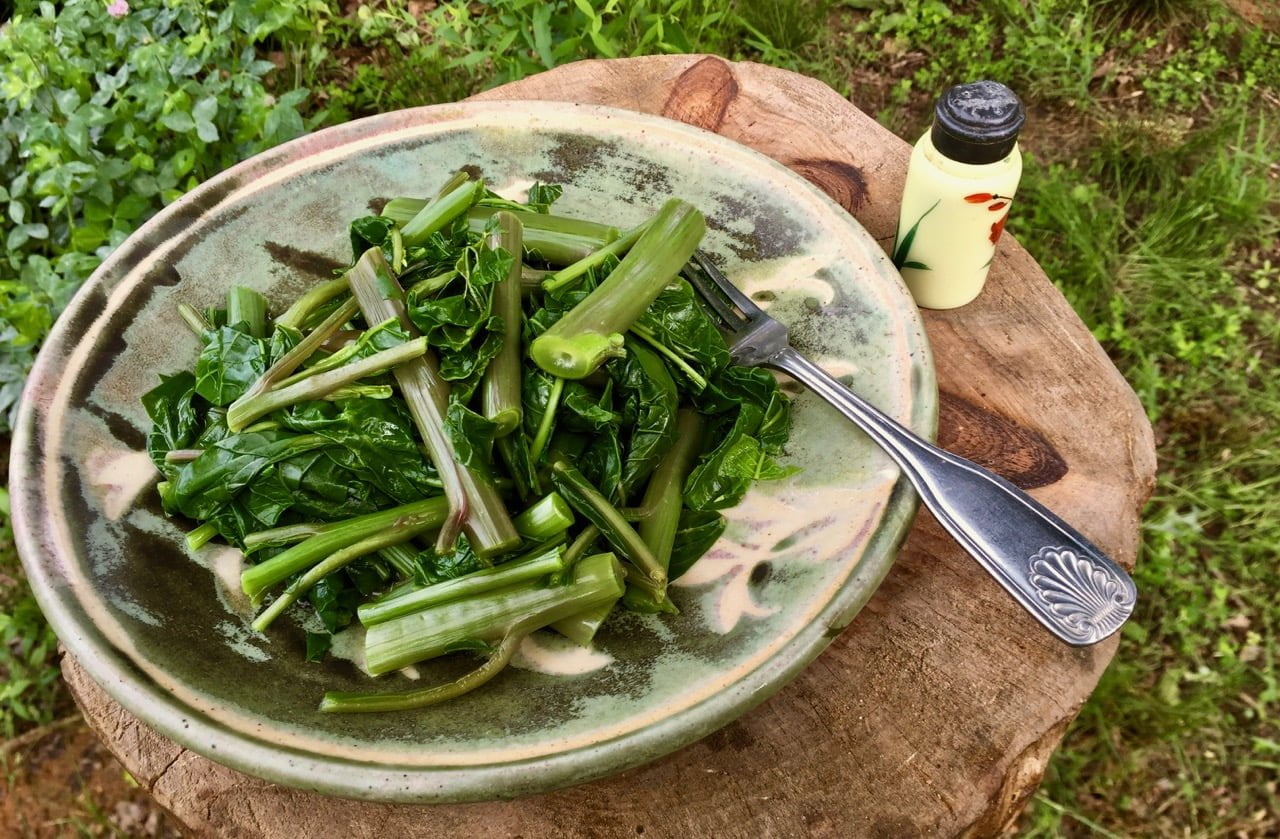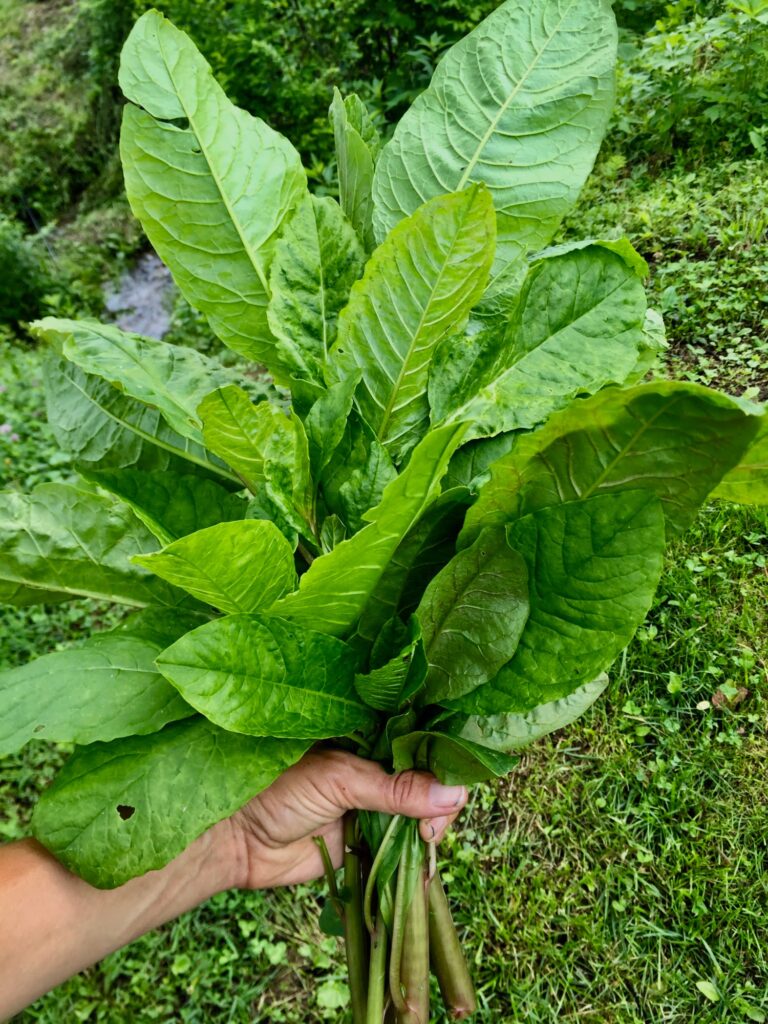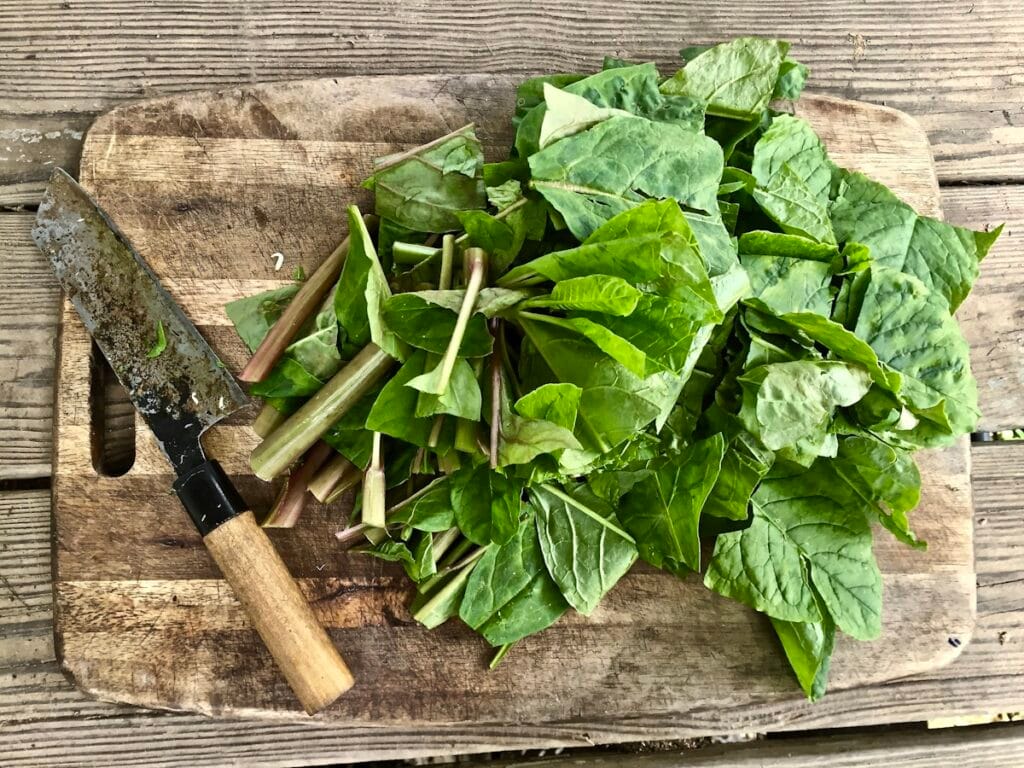
Pokeweed is a nutritional powerhouse, but be careful, it can also be toxic to humans if it’s not prepared correctly. Learning how to prepare poke salad correctly ensures you get the benefits without the risk. This voluptuous weed is extremely high in vitamin A, and also has significant amounts of vitamin C, iron and calcium. Additionally, pokeweed contains a unique antiviral protein that may inhibit the growth of some herpes simplex viruses and even HIV!
Pokeweed is one of the first plants to sprout in the springtime. Because of that, its traditionally eaten to get people through the early spring, along with other “weeds” like chickweed and nettles. It also has lymphatic cleansing properties and helps the body with “spring cleaning. Knowing how to eat pokeweed properly is essential to enjoy its lymph-cleansing and nutritional effects. The best time to harvest pokeweed for food is before the plant reaches knee height (well before it flowers). When you weed your garden, pokeweed is one you might skip over, so you can enjoy its benefits.


The common name, poke, comes from a word for “blood” or “dye” in a language indigenous to North America (probably Powhatan or Virginia Algonquin). That’s because pokeweed’s bright berries can be used to make dye when they’re ripe.
We teach about loads of edible weeds in our Online Gardening School. If you’re interested in expanding your wild plant knowledge even further, it’s a great resource for learning to identify, harvest, and prepare edible and medicinal plants safely. You can also check out our Wildcrafted Apothecary Class, if you’re looking for more information on herbalism.
Poke salad or poke sallet?


Pokeweed is always eaten cooked. In fact, raw poke can make you sick or even kill you. It’s especially dangerous for children and older folks. Even though that sounds scary, don’t worry; we’re going to walk you through how to render this tender plant into something safe and delicious.
The term “poke salad” is actually a misnomer. Even though that’s what a lot of people call the most common pokeweed dish, its true name is poke sallet or poke salat. That’s because poke has been eaten for so long by our European ancestors here in North America. The word sallet comes from an older form of English, and refers to something like a cooked salad. So, now you know: “poke salad” is actually poke sallet.
Poke Salad Recipe (or how to make “poke sallet”)


- Start two pots of water on the stove (covered), one the size to fit the poke that you have harvested, one at least 3 times this size
- Coarsely chop poke shoots
- When water has come to a boil in the small pot, and is close to or is boiling in the big pot, add poke to small pot. Stir, so that all poke is submerged
- Cook for approximately 2 minutes, or until water returns to a boil
- Place lid over small pot in such a way that it stops greens from escaping as you pour offwater, or use colander to drain water, then put greens back in small pot
- Pour already boiling water from big pot over poke in small pot, cook for approximately 2 minutes, or until water returns to a boil
- Repeat steps 4 and 5 one to three more times, depending on flavor preference, and tolerance of (and desire for) the lymphatic cleansing and poison ivy relieving effects of pokeweed
- Optional: add salt and the traditional combo of bacon grease and molasses
After processing in such a manner, greens should still be bright green and appear vital. Enjoy!
Pokeweed Identification Tips
Pokeweed is easy to identify once you know what to look for. In the spring, the young shoots are smooth and green with reddish or purplish highlights on the stems. As the plant matures, it can grow up to 10 feet tall, developing thick, reddish-purple stalks and large, lance-shaped leaves. In late summer, it produces long, drooping clusters of dark purple berries. Be sure not to confuse pokeweed with similar plants like elderberry or milkweed. If you’re new to wild foraging, consult an expert before harvesting. You can also deepen your understanding of foraging and plant ID in our Online Gardening School, which offers seasonal guidance for working with wild edibles like pokeweed.
Cultural and Historical Uses of Pokeweed
Pokeweed has a rich history in North America, both as a food source and as a medicinal plant. In the American South, poke salad was once considered a staple during hard times when fresh vegetables were scarce. It was often served with cornbread or beans. Indigenous communities have also used pokeweed for generations. The berries were used as a natural dye, and the roots were incorporated in carefully prepared traditional medicines. Today, poke salad continues to be enjoyed for its deep cultural roots and seasonal significance.
When Not to Use Pokeweed
While pokeweed has many benefits, there are important times when it should be avoided altogether. Do not consume any part of the plant once it has started flowering or forming berries — the older the plant, the more toxic it becomes. Individuals who are pregnant, nursing, or have compromised immune systems should steer clear of pokeweed even when prepared properly. If you’re unsure about the plant’s stage or how it was cooked, it’s best to skip it. Safety and proper identification are always top priorities when working with wild foods.
Is Poke Salad Poisonous?
Yes, poke salad can be poisonous if it’s not prepared correctly. Raw pokeweed contains toxic compounds that can cause nausea, vomiting, or worse — especially for children and the elderly. That’s why proper preparation is so important. Following a trusted poke salad recipe and boiling the greens multiple times removes the harmful substances and makes this wild green safe to eat. Never eat pokeweed raw, and always harvest young shoots before the plant matures.
How to Eat Pokeweed Safely
Knowing how to eat pokeweed safely is key to enjoying this traditional Appalachian food. Only the young, tender shoots — harvested before the plant flowers — should be used for cooking. After thorough boiling and draining, poke greens can be enjoyed hot with bacon grease and molasses, or added to casseroles and savory pies. If you’re curious about how to prepare poke salad in creative ways, try substituting it for cooked spinach in your favorite dishes.
Poke Salad Benefits
Despite the need for careful preparation, poke salad offers impressive nutritional and medicinal benefits. The boiled greens are rich in vitamins A and C, iron, and calcium. Traditional uses also include poke as a lymphatic cleanser and spring tonic. Some herbalists believe the benefits of poke salad extend to immune and skin health when eaten in moderation. Always consult an expert before incorporating wild plants into your diet regularly.
You can learn about the benefits of other seasonal wild edibles in our Online Gardening School, which offers comprehensive lessons in safe wild plant harvesting and use.
Poke Root Benefits and Uses
Poke root, the underground part of the pokeweed plant, has been used in traditional herbal medicine for centuries. It is most commonly used in the form of tinctures or oils. The benefits of poke root may include immune stimulation, lymphatic system support, and relief from swollen glands. However, poke root is highly potent and must be used with caution. We do not recommend ingesting poke root without guidance from an experienced herbalist.
Poke Root Oil Benefits
Poke root oil is made by infusing the root in a carrier oil, and it’s used externally. Advocates of poke root oil claim it can help reduce inflammation, support breast health, and soothe sore muscles or swollen lymph nodes. As with internal poke root remedies, poke root oil should be used mindfully and with proper research or herbal supervision.
Frequently Asked Questions About Pokeweed
Only the young, tender shoots of pokeweed — harvested before the plant flowers — are safe to eat when properly prepared. Older parts of the plant, including the leaves, stems, berries, and roots, can be toxic. Always boil the shoots in several changes of water before consuming.
Most recipes recommend boiling poke greens in at least two to three changes of water. This helps remove the toxic compounds that naturally occur in the plant. The number of boils can depend on personal flavor preference and how sensitive your body is to the effects of poke.
Yes, once poke salad has been properly boiled and drained, it can be frozen for later use. Store it in airtight containers or freezer bags. When you’re ready to enjoy it, simply reheat and season to taste.
No, pokeweed berries are not safe to eat. While they have been used historically for dyes and in some very controlled medicinal preparations, the berries contain toxic compounds and should be avoided entirely, especially by children and pets.
For a comprehensive guide to identifying and preparing wild plants like pokeweed, explore our Online Gardening School. It’s packed with tips on safe harvesting, preparation, and seasonal uses of dozens of edible and medicinal plants.

